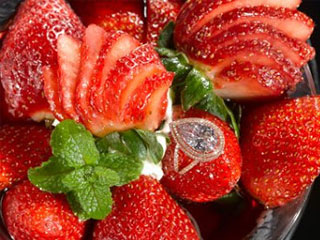 One question I am always asked is, “Where do you get your protein?” First, it is interesting to know that human breast milk is 5% protein. This is the perfect food for babies who are growing more quickly than at any other time in their lives (they are doubling their weight in 180 days!). Since older children and adults are not growing at such a rate, we do not need any more protein than that. The United Nation’s World Health Organization recommends that men and women obtain 5% of their calories as protein. The USDA puts this figure at 6.5%. Our need for protein is easily met with fruits having 4 – 9%, nuts/seeds/sprouts 10 – 25% and vegetables 15 – 50% of their calories from protein.
One question I am always asked is, “Where do you get your protein?” First, it is interesting to know that human breast milk is 5% protein. This is the perfect food for babies who are growing more quickly than at any other time in their lives (they are doubling their weight in 180 days!). Since older children and adults are not growing at such a rate, we do not need any more protein than that. The United Nation’s World Health Organization recommends that men and women obtain 5% of their calories as protein. The USDA puts this figure at 6.5%. Our need for protein is easily met with fruits having 4 – 9%, nuts/seeds/sprouts 10 – 25% and vegetables 15 – 50% of their calories from protein.
How about calcium? Plenty of calcium is found and more easily absorbed into your body from plant foods. In fact, only 30% of the calcium in a cup of milk is actually absorbed by the body. Your body would get twice as much calcium from a cup of broccoli. The problem is that the body uses a lot of calcium in the process of excreting all the excess animal protein and will leach it out of your bones if necessary to get the job done. Plant protein doesn’t create that kind of problem. Plus, there is more calcium in many fresh green vegetables, fruits and nuts than there is in milk. Almonds have 245 mg, figs 269 mg, broccoli 123 mg and milk has only 115 mg/100g.
Many people worry about getting sufficient iron. Gabriel Cousins, author of Conscious Eating has this to say about anemia (shortage of iron in the body): “Why do vegetarians have less anemia? The answer, I believe, lies in the leafy greens, which often have a higher concentration of iron than flesh foods. For example, according to the USDA Handbook No. 456, gram for gram, kale has fourteen times more iron than red meat. Spinach has approximately eleven times the iron as ground beef. Strawberries, cabbage, bell peppers, and even cucumbers have more iron per weight than ground beef or sirloin steak. Researchers have also found that Vitamin C, which is high in fruits and vegetables, significantly enhances the body’s ability to assimilate iron.”








